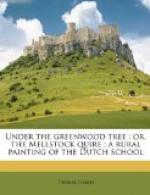It followed that, as the spring advanced, Dick walked abroad much more frequently than had hitherto been usual with him, and was continually finding that his nearest way to or from home lay by the road which skirted the garden of the school. The first-fruits of his perseverance were that, on turning the angle on the nineteenth journey by that track, he saw Miss Fancy’s figure, clothed in a dark-gray dress, looking from a high open window upon the crown of his hat. The friendly greeting resulting from this rencounter was considered so valuable an elixir that Dick passed still oftener; and by the time he had almost trodden a little path under the fence where never a path was before, he was rewarded with an actual meeting face to face on the open road before her gate. This brought another meeting, and another, Fancy faintly showing by her bearing that it was a pleasure to her of some kind to see him there; but the sort of pleasure she derived, whether exultation at the hope her exceeding fairness inspired, or the true feeling which was alone Dick’s concern, he could not anyhow decide, although he meditated on her every little movement for hours after it was made.
CHAPTER II: A MEETING OF THE QUIRE
It was the evening of a fine spring day. The descending sun appeared as a nebulous blaze of amber light, its outline being lost in cloudy masses hanging round it, like wild locks of hair.
The chief members of Mellstock parish choir were standing in a group in front of Mr. Penny’s workshop in the lower village. They were all brightly illuminated, and each was backed up by a shadow as long as a steeple; the lowness of the source of light rendering the brims of their hats of no use at all as a protection to the eyes.
Mr. Penny’s was the last house in that part of the parish, and stood in a hollow by the roadside so that cart-wheels and horses’ legs were about level with the sill of his shop-window. This was low and wide, and was open from morning till evening, Mr. Penny himself being invariably seen working inside, like a framed portrait of a shoemaker by some modern Moroni. He sat facing the road, with a boot on his knees and the awl in his hand, only looking up for a moment as he stretched out his arms and bent forward at the pull, when his spectacles flashed in the passer’s face with a shine of flat whiteness, and then returned again to the boot as usual. Rows of lasts, small and large, stout and slender, covered the wall which formed the background, in the extreme shadow of which a kind of dummy was seen sitting, in the shape of an apprentice with a string tied round his hair (probably to keep it out of his eyes). He smiled at remarks that floated in from without, but was never known to answer them in Mr. Penny’s presence. Outside the window the upper-leather of a Wellington-boot was usually hung, pegged to a board as if to dry. No sign was over his door; in fact—as with old banks and mercantile houses—advertising in any shape was scorned, and it would have been felt as beneath his dignity to paint up, for the benefit of strangers, the name of an establishment whose trade came solely by connection based on personal respect.




